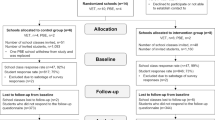Abstract
This study investigated the effects of a smoking prevention program that emphasized refusal skills training on 1730 adolescents in three high schools and six middle schools. Classes within these schools were randomly assigned to treatment or no-treatment conditions to avoid confounding schools with treatment condition. The effects of attrition on the internal and external validity of the study were examined. Although the results indicated an apparent effect of the program at the 1-year follow-up in deterring continued smoking among those who were smoking at pretest, this result may have been due to a higher rate of attrition among high-rate smokers in the treatment condition than in the control condition. Attrition also affected external validity. Across both conditions, subjects who were smoking at pretest and who were at risk to smoke were more likely to be missing at follow-up. The program did have an effect on the refusal skills of participants and the validity of this effect was not jeopardized by differential attrition.
Similar content being viewed by others
References
Ary, D., Biglan, A., Nautel, C. L., Weissman, W., and Severson, H. H. (1983).Longitudinal prediction of the onset and change in rate of adolescent smoking. Paper presented at the Fifth World Conference on Smoking and Health, Winnipeg, Canada, July.
Bauman, K. E., and Dent, C. W. (1982). Influence of an objective measure on self-reports of behavior.J. Appl. Psychol. 67(5): 623–628.
Bell, D., Associates (Producer) (1977).The Feminine Mistake (film), Pyramid Films, Los Angeles. (Supported by a grant from the American Cancer Society.)
Biglan, A., and Ary, D. V. (1985). Current methodological issues in research on smoking prevention. In Bell, C., and Battjes, R. (eds.),Prevention Research: Deterring Drug Abuse Among children and Adolescents, NIDA Research Monograph, U.S. Government Printing Office, Washington, D.C.
Biglan, A., and Lichtenstein, E. (1984). A behavior-analytic approach to smoking acquisition: Some recent findings.J. Appl. Psychol. 14(3): 207–223.
Biglan, A., Severson, H. H., Hops, H., Faller, C., Ary, D. V., Friedman, L. S., Weissman, W., and Nautel, C. L. (1983). Methodological considerations in studying the smoking acquisition process. Paper. presented at the 91st Annual Convention of the American Psychological Association, Anaheim, Calif., Aug.
Botvin, G. J., and Eng, A. (1980). A comprehensive school-based smoking prevention program.J. School Health 50: 209–213.
Botvin, G. J. and Eng, A. (1982). The efficacy of a multicomponent approach to the prevention of cigarette smoking.Prev. Med. 11: 199–211.
Botvin, G. J., and Wills, T. A. (1985). Personal and social skills training: Cognitive-behavioral approaches to substance abuse prevention. In Bell, C., and Battjes, R. (eds.),Prevention Research: Deterring Drug Abuse Among Children and Adolescents, NIDA Research Monograph, U.S. Government Printing Office, Washington, D.C.
Cook, T. D., and Campbell, D. T. (1979).Quasi-Experimentation: Design and Analysis Issues for Field Settings, Rand McNally College, Chicago.
Evans, R. I. (Director) (1976).Resisting Pressures to Smoke [film], Social Psychological Deterrents of Smoking in Schools Project, Houston, Tex.
Evans, R. I., Hansen, W. B., and Mittelmark, M. B. (1977). Increasing the validity of self-reports of smoking behavior in children.J. Appl. Psychol. 62(4): 521–523.
Evans, R. I., Rozelle, R. M., Mittelmark, M. B., Hansen, W. B., Bane, A. L., and Havis, J. (1978). Deterring the onset of smoking in children: Knowledge of immediate physiological effects and coping with peer pressure, media pressure, and parent modeling.J. Appl. Soc. Psychol. 8(2): 126–135.
Flay, B. R., d'Avernas, J. R., Best, J. A., Kersell, M. W., and Ryan, K. B. (1986). Cigarette smoking: Why young people do it and ways of preventing it. In McGrath, I., and Firestone, P. (eds.),Pediatric and Adolescent Behavioral Medicine, Springer-Verlag, New York (in press).
Hansen, W. B., Collins, L. M., Malotte, C. K., and Johnson, C. S. (1983).Attrition in prevention research. Paper presented at the 91st Annual Convention of the American Psychological Association, Anaheim, Calif., Aug.
Hops, H., Weissman, W., Biglan, A., Thompson, R., Faller, C., and Severson, H. H. (1986). A taped situation test of cigarette refusal skill among adolescents.Behav. Assess. 8: 145–154.
Hurd, P., Johnson, C. A., Pechacek, T. F., Bast, L., Jacobs, D. R., and Luepker, R. V. (1980). Prevention of cigarette smoking in seventh grade students.J. Behav. Med. 3(1): 15–28.
Murray, D. M., Johnson, C. A., and Luepker, R. V. (1983). The prevention of cigarette smoking in children: A comparison of four strategies. Unpublished manuscript, Laboratory of Physiology Hygiene, University of Minnesota, Minneapolis.
Pechacek, T. F., Murray, D. M., Luepker, R. V., Mittelmark, M. B., Johnson, C. A., and Schultz, J. M. (1984). Measurement of adolescent smoking behavior: Rationale and methods.J. Behav. Med. 7: 123–140.
Perry, C., Maccoby, N., and McAlister, A. L. (1980). Adolescent smoking prevention: A third-year follow-up.World Smoking Health 5: 40–45.
Severson, H. H., and Ary, D. V. (1983). Sampling bias due to consent procedures with adolescents.Addict. Behav. 8: 433–437.
Telch, M. J., Killen, J. D., McAlister, A. L., Perry, C. L., and Maccoby, N. (1982). Long-term follow-up of a pilot project on smoking prevention with adolescents.J. Behav. Med. 5(1): 1–8.
Author information
Authors and Affiliations
Additional information
This research was supported in part by Grant HD13409 from the National Institute of Child Health and Human Development and by Grant HD15825 from the National Institute of Child Health and Human Development. The authors would like to thank the teachers and school administrators who made this study possible and the more than 10 other staff members who worked on the project. They also thank Lisa James and Stephanie Shaff for their assistance in the preparation of the manuscript.
Rights and permissions
About this article
Cite this article
Biglan, A., Severson, H., Ary, D. et al. Do smoking prevention programs really work? Attrition and the internal and external validity of an evaluation of a refusal skills training program. J Behav Med 10, 159–171 (1987). https://doi.org/10.1007/BF00846424
Accepted:
Issue Date:
DOI: https://doi.org/10.1007/BF00846424




